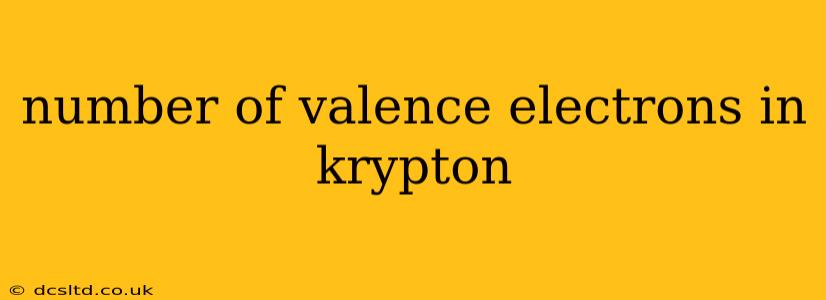Krypton, a noble gas with the symbol Kr and atomic number 36, is known for its chemical inertness. This inertness is directly related to its electronic configuration and, specifically, the number of valence electrons it possesses. Understanding the number of valence electrons in krypton is crucial for grasping its chemical behavior and properties. This article will explore this topic in detail, answering common questions surrounding krypton's electron structure.
How Many Valence Electrons Does Krypton Have?
Krypton has eight valence electrons. This is a key characteristic that dictates its stability and lack of reactivity.
What are Valence Electrons?
Before delving deeper into krypton, let's define valence electrons. Valence electrons are the electrons located in the outermost shell (or energy level) of an atom. These electrons are the ones involved in chemical bonding and determine an element's chemical properties. Atoms strive for a stable electron configuration, often by gaining, losing, or sharing valence electrons to achieve a full outermost shell, typically containing eight electrons (the octet rule).
Krypton's Electron Configuration and Valence Electrons
Krypton's electron configuration is [Ar] 3d10 4s2 4p6. This notation indicates that krypton has two electrons in the 4s subshell and six electrons in the 4p subshell, adding up to eight valence electrons in its outermost shell (the fourth shell). The [Ar] represents the electron configuration of Argon, a noble gas, signifying that krypton’s inner shells are filled similarly to Argon’s.
Why is Krypton Inert?
The presence of eight valence electrons in krypton's outermost shell makes it exceptionally stable. This full outermost shell means that krypton has no tendency to gain, lose, or share electrons to form chemical bonds with other atoms. This is why krypton is considered a noble gas, characterized by its extreme chemical inertness. It rarely participates in chemical reactions under ordinary conditions.
Does Krypton Ever Form Compounds?
While exceptionally rare, krypton can form compounds under extreme conditions, such as high pressure or low temperatures. These compounds are typically unstable and break down easily. The formation of these compounds usually involves highly electronegative elements like fluorine. Even then, these compounds are exceedingly rare and not typically encountered in everyday chemistry.
What are Some Applications of Krypton?
Krypton's inertness makes it suitable for various applications. Some notable uses include:
- Lighting: Krypton is used in fluorescent lights and some high-intensity discharge lamps to produce a brighter and whiter light than neon.
- Lasers: Krypton lasers are used in various applications, such as in surgery and in certain types of spectroscopy.
- Photography: Krypton flash tubes were once used in high-speed photography.
How is the Number of Valence Electrons Determined?
The number of valence electrons can be determined by examining an element's position on the periodic table or its electron configuration. For elements in groups 1-18 (using the older group numbering), the group number (excluding transition metals) often indicates the number of valence electrons. However, electron configuration provides the most accurate method, as seen in the case of krypton.
In conclusion, krypton possesses eight valence electrons, a key factor in its chemical inertness and its unique applications in various fields. Understanding this fundamental aspect of krypton's atomic structure provides insight into its remarkable properties and behavior.
